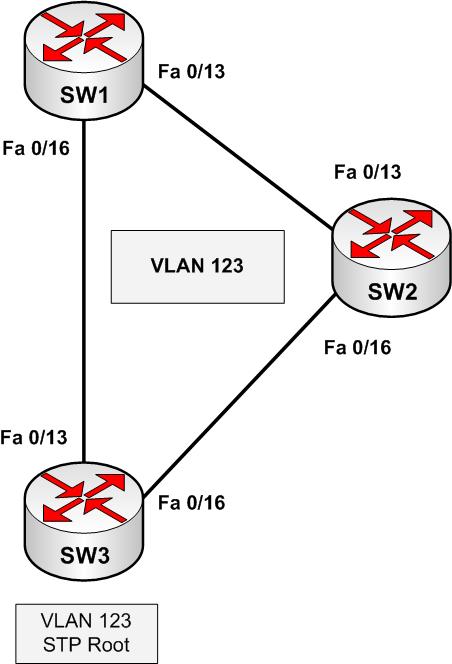CCIE Brainteaser: STP
For the sake of simplicity and enabling a wider audience we decided to post our regular CCIE brainteasers to the blog. The winner will get a coupon worth 10% off the price of any of our training packages for R&S, Security, Voice or Service Provider or a $250 Amazon.com gift card! Note that the 10% off discount can not be used with any other discount code you may already have. Please post your solution under the comments for this blog entry - the first person to post the correct solution is the winner. Make sure you provide the correct email address in your response so we can contact you in the event you won. On Tuesday (August 12th) we will post the solution and announce the winner.
For today the task is an easy one or at least appears to be ;-) Imagine a simple topology made of 3 switches:
All switches are running STP for VLAN123 with SW3 being the root. Your task is to configure the network in such a way so that SW1 port fa0/13 is the root port and SW1 port fa0/16 is the alternate port for VLAN 123. Sound easy? Here are the requirements:
1) Do not change any STP link cost
2) SW3 must remain the root for VLAN 123
3) The port types must be access
4) Do not use the switchport backup interface command
5) Do not try to use SPAN or RSPAN
6) Do not disable STP
Good luck!
The correct solution is:
1) Configure SW2 to tunnel STP BPDUs between SW1 and SW3. This will make SW1 thinking that that SW3 is directly connected with cost 19. STP is still active on SW2, but SW2 considers itself the root.
SW2:
interface FastEthernet 0/13
l2protocol-tunnel stp
!
interface FastEthernet 0/16
l2protocol-tunnel stp
2) Configure SW3 port Fa0/16 with lower STP priority than SW3 Fa 0/13. This will make SW1 select its connection to SW2 as the root port and the other uplink is alternate: both uplinks have equal costs, the upstream port priority is the tiebreaker.
SW3:
interface FastEthernet 0/16
spanning-tree port-priority 64
Below is a summarization of some of the close but not quite correct approaches people submitted:
1) Change interface bandwidth/speeds. This is not allowed, since the requirement was not to change spanning-tree costs.
2) Use dot1q tunnel on SW2 – this was prohibited by requirement to set port modes to access
3) Filter spanning-tree BPDUs coming to SW1 from SW3. This would break the requirement for Fa 0/16 port to be alternate path to root. Aside from that, that would result in STP loop, since this is a circular topology.
4) Disabling STP in SW2 explicitly which is prohibited by the requirements
5) Incorrectly assuming that port-priority on SW1 may influence root port selection
6) One complicated MSTP solution submitted by two people actually works but was submitted after the above solution was posted. The solution is based on differentiation between regional root and CIST root. Not the simplest solution but it works. The two people that posted this solution also deserve credit for their MSTP knowledge. We'll do a post on MSTP inter-region operations here on the blog in the next few days.
The winner is: "Roman” roman.aprias@[snip].com
